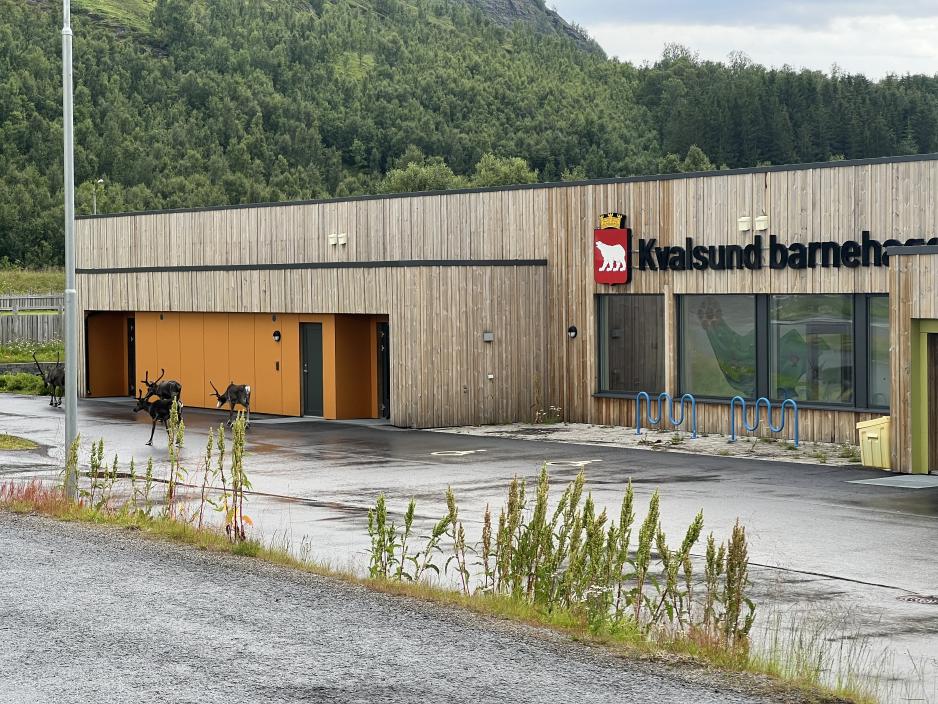Op-ed: When the Snowy Owl Rescued the Reindeer

Researcher Larry Ibrahim Mohammed shares some lessons from the rejected Kvalsund wind power project in this op-ed. The photo shows reindeers passing Kvalsund kindergarten. (Photo: Larry Ibrahim Mohammed)
Although Norway boasts of many laws that secure participation and protection of Sami rights, the practical implementation falls short of expectations. This leaves doubts in the hearts of the Sami community, who are worried about the erosion of trust, and the Norwegian government must do what it can to change the situation, writes PhD Research Fellow Larry Ibrahim Mohammed.
This is an opinion piece written by external contributors. All views expressed are the authors' own.
Between 2000 and 2019, about 30 energy companies expressed their interest in constructing wind power in areas with Sami reindeer herding. Of the 93 registered interests to the NVE, about 44 were fully processed, resulting in 31 licenses granted and 13 rejections.
The rest of the applications were either withdrawn by the energy companies or had their processes halted.
Despite these diverse wind power cases, we know very little about their processes and the main factors that lead to granting or rejecting their licenses, especially when these projects affect south and north Sami reindeer herders.
This article presents the findings of the Kvalsund wind power project as a departure from the popular Fosen case. The question that tickles most minds is whether the results from this rejected wind power application in Northern Norway can inform us about the influence of Sami participation.
The Kvalsund wind project, led by Finnmark Kraft and Fred Olsen Renewable, submitted its application and impact assessment in November 2011. The project aimed to build a 128MW wind power plant that would generate about 391Gwh of green power annually. It also considered constructing a 5.3km access road, a transformer station, and a 31km internal road network.
Can this inform us about the influence of Sami participation?
Like many other industrial projects in Finnmark, the proposed site overlapped with grazing areas used by the Fiettar Reindeer Herding District. The herders opposed the project, insisting it would affect summer grazing, aeration, and calving areas of reindeer herding.
The Sami Parliament highlighted the cumulative effects of other projects, such as the proposed Nussir Mine, powerlines and cabin developments. At the same time, the Reindeer Herding Administration in West Finnmark submitted a conflict assessment to the energy regulator, warning of a high conflict with reindeer herding.
In the Kvalsund case, it was not only the Sami actors who raised their voices. A resident of Kvalsund had informed the consultant working on the impact assessment on nature biodiversity about seeing a snowy owl in the area.
As a circumpolar bird on the Norwegian Red list of vulnerable species, the snowy owl uses parts of the Norwegian, Russian, and Canadian Arctic for nesting and breeding.
Eventually, a report from the Norwegian Institute for Nature Research (NINA) on the Snowy Owl Project confirmed the snowy owl's vulnerability and activities around the planning area.
This information influenced the Directorate for Nature Management to advise against licensing the project. On January 11, 2013, the Norwegian Water and Energy Directorate (NVE) rejected the wind power application, stating that concerns for both the reindeer husbandry industry and biodiversity influenced its decision.
What do we learn from this case? Several things come to mind. As citizens, we have the responsibility to participate in such public processes and share relevant information with researchers and authorities.
When we see something, we must say something, especially when biodiversity creatures, unlike humans, cannot defend themselves. The Kvalsund case also teaches us the importance of funding institutions and international projects to conserve biodiversity.
Even though there were no studies on how wind power affected the snowy owl specifically, the NVE elected to use the precautionary principle to protect the declining population of the snowy owl.
When it comes to how Indigenous rights impacted the decision of the NVE, there are some uncertainties in the NVE's explanation. Even when the NVE explained that it took reindeer herding into consideration, the decision did not sufficiently justify this claim, leaving some doubts.
For example, there was no mention of any legal basis connected to Sami rights in the decision, as was done for the snowy owl; the knowledge base of how wind power affected reindeer herding prioritized consultant reports ahead of traditional expert knowledge of reindeer herders, and the Reindeer Herding Administration in West Finnmark.
Furthermore, the objection of the Sami Parliament to the lack of cumulative assessment was overruled in the process, and no consensus was reached during negotiations.
As citizens, we have the responsibility to participate in such public processes.
As Norway pursues new wind power projects in Finnmark, following the Norwegian government’s approval to electrify the gas processing plant at Melkøya, the balance between emissions reduction, biodiversity protection and Sami rights must be carefully managed.
Although Norway boasts of many laws that secure participation and protection of Sami rights, their practical implementation falls short of expectations. This leaves doubts in the hearts of the Sami community, who are worried about the erosion of trust, and the Norwegian government must do what it can to change the situation.
When I informed a Sami professor I met about my research on the rejected Kvalsund wind power at a 2023 conference in Faroe Island, he responded, “Maybe we need more of the snowy owls at reindeer herding areas”. His response highlights the urgency of addressing the Sami-state trust deficit.
The full scientific article can be read here: Saved by the snowy owl: An intersectional analysis of indigenous rights and biodiversity in the Kvalsund wind power project in Norway - ScienceDirect.

